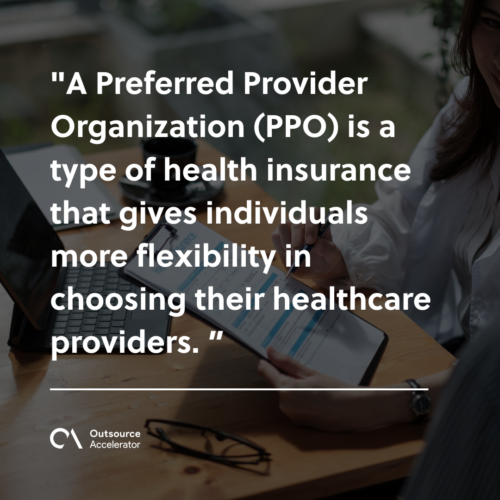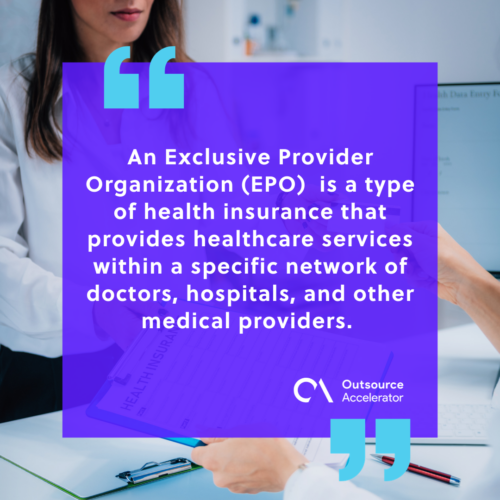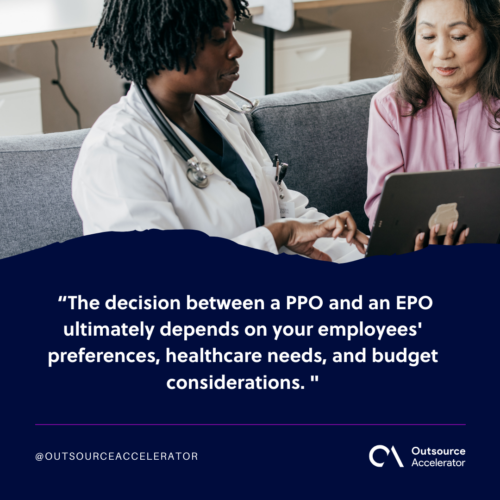PPO vs. EPO: Understanding the differences

Healthcare coverage is one of the most significant benefits employers can offer their workforce.
Preferred Provider Organization (PPO) and Exclusive Provider Organization (EPO) plans stand out among the various options available.
Understanding their differences can greatly impact the health and satisfaction of your employees.
Here’s a comprehensive PPO vs. EPO breakdown to help you decide which plan best suits your company’s needs.
What is a PPO plan?
A Preferred Provider Organization (PPO) is a type of health insurance that gives individuals more flexibility in choosing their healthcare providers.
PPO plans have preferred doctors, specialists, and hospitals but allow members to seek medical services outside this network.
When individuals leave the network, they usually have to pay higher costs. However, choosing any healthcare provider without a referral is a significant advantage of PPO plans.
Overall, PPO balances the choice of doctors and cost flexibility.

What is an EPO plan?
An Exclusive Provider Organization (EPO) is a type of health insurance that provides healthcare services within a specific network of doctors, hospitals, and other medical providers.
Unlike PPO plans, EPO usually doesn’t cover care outside this network except in emergencies. This plan often comes with lower premiums and out-of-pocket costs than PPO plans.
However, individuals must stick to in-network providers for non-emergency medical services. EPO plans offer cost savings by emphasizing a limited network of healthcare providers.

PPO vs. EPO: Key differences
Below are the key differences between PPO and EPO:
Provider flexibility
- PPO: Offers more freedom in choosing healthcare providers, allowing visits to both in-network and out-of-network doctors and specialists.
- EPO: Limits coverage to in-network providers only, except in emergencies. It provides a more restricted choice of healthcare professionals.
Cost variations
- PPO: Typically involves higher premiums and out-of-pocket costs due to the broader coverage that includes out-of-network services.
- EPO: Generally, this plan features lower premiums and out-of-pocket expenses as it concentrates on in-network care, reducing overall costs.
Referral system
- PPO: Often doesn’t require referrals from primary care doctors to see specialists, allowing more direct access to specialty care.
- EPO: Similarly, this plan doesn’t usually mandate referrals for specialist visits within the network.
Network size
- PPO: Tends to have a larger network of healthcare providers, offering more choices for individuals seeking medical services.
- EPO: The network is more limited, which means fewer choices of healthcare providers. However, this can result in more cost-effective care within that specific network.
PPO vs EPO: Factors to consider in plan selection
When deciding between a PPO and an EPO for your employees’ health coverage, several critical factors should guide your choice:
Health needs
Consider your employees’ specific health requirements. A PPO plan might be more suitable if they value a wide range of healthcare options and have diverse medical needs.
Geographical factors
Evaluate the geographical locations of your workforce. Suppose most of your employees are in areas where the EPO’s network of providers is good. Choosing an EPO plan could save money and be a smart option.
Additional benefits
Examine the supplementary benefits offered by each plan. PPO and EPO may include wellness programs, telemedicine services, or other perks that can enhance your employees’ overall health and well-being.
Coverage needs
Assess the specific coverage needs of your workforce. Consider factors such as:
- Prescription drug coverage
- Preventive care
- Availability of specialists within the network.
This ensures that the chosen plan adequately addresses the needs of your employees.
Life changes and future needs
Anticipate potential life changes among your employees, such as the possibility of family expansions, relocations, or changes in health status.
Select between the PPO and EPO that can adapt to these evolving needs to provide flexibility and coverage for the future.
Customer service and support
Consider the quality of customer service and support provided by each plan.
A responsive and helpful customer service team can improve your employees’ experience when dealing with claims, inquiries, or issues related to their coverage.
Coverage during travel
Examine how the PPO and EPO plan addresses coverage during travel. They may offer better flexibility and coverage for employees who frequently travel.
This ensures they can access medical services when away from their usual location.
Flexibility and accessibility
Evaluate each plan’s flexibility and accessibility. Determine how easily employees can schedule appointments, access care, and navigate the healthcare system.
Evaluating the plan’s network of healthcare providers is essential, as it impacts the quality and variety of medical services available to you.
Quality of care
Consider the quality of care provided by the network of healthcare providers associated with the PPO and EPO plan.
A plan with a strong network of high-quality healthcare professionals can positively impact your employees’ health outcomes and satisfaction.
In a PPO, you can see specialists without a referral from your primary care provider (PCP), while an EPO requires referrals for specialist visits through your designated PCP.
Prescription drug coverage
Review the prescription drug coverage offered by each plan and ensure that it adequately addresses your employees’ medication needs.
PPO vs. EPO: Comparison of features
Here’s a quick breakdown comparing the main features between PPO and EPO:
| PPO | EPO | |
| Coverage | Covers both in-network and out-of-network providers | Covers only in-network providers |
| Flexibility | Offers high flexibility by allowing members to see any provider without referrals | Provides less flexibility, as members must stay within the network |
| Costs | Typically comes with higher premiums, deductibles, and out-of-pocket costs | Generally has lower premiums and out-of-pocket costs, making it a more budget-friendly option |
| Provider network size | Often has a larger provider network for more healthcare options | Usually has a smaller, more limited provider network |
| Suitable audience | Ideal for members who frequently require specialized care, prefer flexibility, and don’t mind paying higher costs for the option to go out-of-network | Best suited for those who want to keep costs low and are comfortable staying within a defined provider network |
PPO vs. EPO: Which is better?
The decision between a PPO and an EPO ultimately depends on your employees’ preferences, healthcare needs, and budget considerations.

While a PPO offers greater flexibility, an EPO provides a cost-effective solution with a more restricted network.
Carefully weigh these factors to choose the plan that aligns best with your employees’ well-being and your company’s financial goals.
PPOs offer you the flexibility to seek care from any healthcare provider without requiring a referral from a primary care physician, making them ideal for those who prefer freedom of choice.
On the other hand, EPOs focus on a health maintenance organization, mandating you to consult a primary care physician for specialist referrals, which might appeal more to individuals seeking streamlined care coordination.
Assessing your priorities, such as provider selection and cost-effectiveness, can help you make an informed decision about which health insurance plan aligns best with your healthcare requirements and lifestyle.







 Independent
Independent




